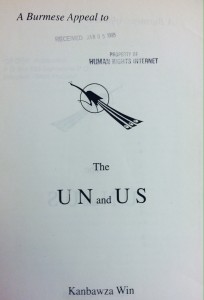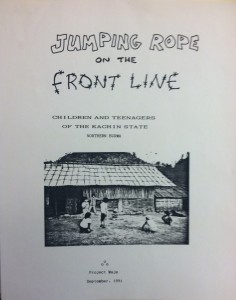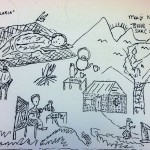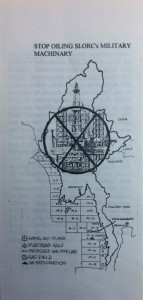–Matt Jones is a PhD candidate in the English department at the University of Connecticut. His work focuses on post-Enlightenment discourse in 18th– and 19th-century British literature. He has contributed to the processing and description of the Laurie S. Wiseberg and Harry Scoble Human Rights Internet and contributes research commentary on the collection to the Human Rights Archives Blog.
A lingering feeling of hopelessness permeated the old and young villagers of northern Burma under the SLORC – State Law and Order Restoration Council – regime of the 1980s and 1990s. The SLORC did not discriminate based on age, nor did the poor living conditions that became perpetuated under them. In interviews conducted with local children by Project Maje along the Burma – China border in 1991, multiple interviewees reported having already contracted malaria, theft of livestock by the Burmese government, and the early death of siblings. Nearly all of the children reported that fleeing from government forces brought them to the villages they now inhabit. A separate set of interviews with adults in the area revealed what treatment the children had to look forward to should they make it to adulthood. Adult interviewees related experiences of forced labor by the SLORC forces (called “portering”), SLORC agents requiring money or goods from traders on their way to market, and the torture of those too enfeebled to participate in forced labor. Each interview ended with the question of whether there was any hope for the future: the general answer was “no” with an occasional nod toward the desire for a true democracy.
These testimonies reflect small, individual experiences of trials that in this time had reached epidemic levels throughout Burma. By 1990 maternal mortality rates had reached 580 per 100,000 live births (compared with 80 and 10 in Malaysia and Singapore). Infant mortality rate by 1995 was 105 for every 1,000 live births. Forced army recruitment of 13 – 15 year-olds is thought to have propelled the total size of the armed forces from 180,000 to approximately 400,000. These children were frequently ordered to act as “human minesweepers” by marching ahead of the rebel troops to discourage – or attract – enemy firepower. Children had no reason to expect theirsituations to change for the better if they survived into adulthood. The “portering” practice mentioned above involved spiriting away able-bodied men, young children, and pregnant women to carry packs for the army that could weigh more than half of the villager’s weight. During this time laborers are neither fed nor offered any medical assistance. Those who refused to cooperate with these demands could expect fines, beatings, rape, or execution.
While in power SLORC and its deeds were not unknown on the world stage. Insider agreements between landowners in northern Burma and the government forces allowed Burma to remain the world’s largest producer of opium and also a major player in the world heroin trade. Investors in Burmese oil included the Nippon Oil Company Ltd – itself a 20% shareholder in Texaco – and the Petroleum Authority of Thailand. SLORC reinforced its hold on state policy in 1990, decreeing in Declaration 1/90 that it “observed no constitution,” that “its legitimacy did not come from the people but from the fact that it was accepted as the government of Burma by the United Nations and the nations of the world,” and that “it will continue to rule until a government is formed in accordance with a new constitution.” By 1993 admonitions from both the UN and the Clinton administration were felt by most Burmese who were aware of them to have rung false. The US had cut off antinarcotic aid to SLORC in 1988, but it was clear that turning a blind eye was not sufficient to induce progress. By 1993 the United Nations General Assembly had passed “consensus resolutions for SLORC to respect the will of the Burmese people” by respecting election results, but all for naught. The military junta was only officially dissolved in 2011 after a 2010 election. In spite of this the average annual income of the majority of Burmese citizens remains under $200 [American] per capita.
-Matt Jones, Student Library Specialist




